X-Plane 940 now supports normal maps on OBJ models (both scenery and airplane). I’ll get more formal docs up once the rest of my office is moved and unpacked but here’s the details for now:
The normal maps are in “blender” format see here. The alpha channel is optional; if it is present, it serves to modulate the level* of specularity. Opaque means full specularity, transparent means none. You can use this feature to make some parts of an object shiny and some dull on a per-pixel level.
Shininess level is modulated by both ATTR_shiny_rat and the alpha channel, so you need ATTR_shiny_rat 1.0 and an opaque alpha channel (or no alpha channel) to see full specularity.
Normal maps are only available for objects and only appear if pixel shaders are on and per-pixel lighting is enabled.
Normal maps should be PNG format, not DDS – they will not be texture compressed because S3TC compression tends to kill them. (There are some modern formats for normal map compression supported by the newer cards but we don’t use them yet.)
* Specular level: most serious 3-d programs let you control both the specular exponent, which controls how “tight” the specular hilights are, and the specular level, which controls how bright they are. X-Plane only lets you control specular level; if specular hilights exist, they are always as the maximum exponent for the sharpest specular hilights.
X-Plane 940 beta 1 is out…it will take a little bit to get the release notes and docs on the website completely up-to-date. We’re still dealing with loose ends from our migration to the new web site, and most of my office is packed up for a move to the Boston area. I’ll try to get docs up as fast as I can given the chaos flying about.
Given the interest multi-core stirred up in previous notes, I will mention one change to 940: with this build we’ve added yet more multi-core to X-Plane.
In 931, X-Plane will use as many cores as you have to load textures, but only one to build “3-d scenery” (a loose category for the work we do when we make airport taxiways and lines, build forests, and extrude roads).
In 940, this “3-d scenery” is also done on as many cores as you have. This should speed up load times a bit, particularly under very heavy tree settings, and hopefully keep the forest engine running faster for users with more cores.
It also sets us up for long-term growth; X-Plane’s visual quality is sometimes limited by the time to build 3-d meshes…being able to do this work on many cores means we can use higher quality algorithms.
Consider for example the roads: my original “road extruder” (the code that converts a vector road into a 3-d model, called an extruder because it builds a 3-d road from a cross section like one of those play-dough toys) made beautiful intersections with stop-lines and cross walks and lots of other great stuff.
It was also really slow. And at the time the sim wouldn’t fly at all while roads were extruded, so speed was of primary concern. So I replaced it with the much dumber extruder you see today, where intersections are basically ignored.
Now that we have 3-d scenery build on multiple cores, we can begin to provide rendering options that take more CPU time but produce higher quality results. The trees and airport layouts already do this (in that they take more time and produce slower, more detailed, higher triangle count sceneery at higher rendering setting for the same input DSF ad apt.dat file). With more cores, we can continue this strategy with roads and other parts of the sim without worrying about overloading the one core that was doing this work.
Of course just because we can use 8 cores doesn’t mean we do…you won’t see 8 cores maxed out very often, particularly if you have simple scenery and a very fast machine.
If I have not emailed you back, it’s probably because I’ve been very busy trying to interleave X-Plane coding and packing up the house. But it is also possible that my email response bounced because my web server has ended up on a bunch of anti-spam “black-lists”.
Black-listing seems like a good idea at first: we’ll gather up a list of all of the IP addresses from which spam comes from, then publish them. Then your local mail server can use that list to filter spam – you never see it!
In practice it doesn’t work so well…example: http://www.mipspace.com/. The IP address for my server (XSquawkBox) is now on this list. Why?
MIPSpace is a list of IP Addresses associated with known commercial marketing companies.
Since my server is used for my own personal email and to run the SDK website, I’m not sure why I am on the list. I have sent them an email to clear things, but in general I hit an anti-spam/black-list bounce somewhat frequently now, and frankly I don’t have time to separately try to clear my name from every guilty-until-proven-innocent blacklist that pops up and screws up my email.
If I seem disproportionately grumpy about this, it could be due to one of two reasons:
-
Not replying to emails is generally bad customer service. (Okay, my in-box is backed up four months…that’s bad.) I don’t like the idea that a customer might perceive us (LR) as being unresponsive because some third party with no skin in the game decides to black-list us.
The blacklist has no incentive to be accurate – it’s not their lost customers if email doesn’t go through.
-
I’m not at all convinced that this is going to cut down unsolicited commercial mail and/or spam.
In the spam case, spammers can send from botnets – they have access to a huge number of ever-changing IPs. Unless we are prepared to blacklist the entire internet, the blacklists are going to pick up more and more false positives while spammers find ways to harvest fresh, untainted IP addresses. The whole IP-reputation strategy assumes that IPs are hard to change. In practice, IPs are very, very easy to change.
Commercial mail is a lost cause too – even if I am being solicited for commercial mail I don’t want, no program or automatic process is ever going to tell the difference between the confirmation of my invoice and a list of discounts from the same company. When it comes to commercial mail, the reputation damage has to be done to the company, not the IP.
(The company does have reputation to risk – if we are known as a company that doesn’t honnor a “do not subscribe” policy, then customers can choose to not buy our products.)
It could also be because I ran out of Viagra and don’t have a diploma from a prestigious non-acredited university.
I will be out of the office next week – it’s August, time to head for the mountains…no cell coverage, no internet, no computers, no electricity…no mountains actually. (This is upstate New York…mountainous to someone from Boston but not mountains compared to what Sergio normally deals with.)
As you know, LR often shows stellar judgement in managing release risk. So in true X-Plane tradition, I swapped in the new revamped website last night, just in time to head for the hills and avoid the fall-out.
Here’s the short version:
- I am wicked stupid.
- When I did the swap last night, I screwed up the files that manage the auto-update functionality, hosing the updater.
- I fixed these files this afternoon, once the message got back to me.
So if you saw weird stuff happen with the updater or the sim last night, please try again – it should be fixed. If it is still broken, please send an email to Austin and myself – one of us will hopefully be around.
I have also reskinned scenery.x-plane.com and wiki.x-plane.com to match the new site. If you find artifacts in those two sub-sites, please email me – I’ll fix it as soon as I can. The wiki site is a MediaWiki skin – it was pretty tricky to get it working, so it may be a bit before I work all the kinks out.
I have set up a public bug database for the scenery tools. The reason is that I don’t have much continuous time to work on the scenery tools – it’s very stop and go and will be for a while. The bug base lets you create a permanent record of a problem that I can’t lose track of in the heat of whatever is on fire today.
WED is almost ready for a beta, but I am just completely swamped with work right now…for WED 1.0 I worked full time on fixing WED bugs for a significant time when WED went beta; this time around I won’t have that kind of time – at least not this year.
So…we’ll see how the bug base works out. My hope is that I can post WED, put it down, and pick up work on it intermittently with the bug base providing a record of what remains to be done.
Regarding other tools, there will be at least one more MeshTool beta with an improved shapefile processing algorithm that will handle broken shapefiles better. The ac3d plugin has some bugs filed against it but it’s possible that they’d be deferred past the 3.2 plugin.
I have been working on OpenStreetMap data for X-Plane this week. Use of OSM for global scenery is going to be a bit different from projects like X-VFR or other specific custom OSM-based scenery.
The issue at hand is accuracy vs. plausibility…
- Accuracy: how much error is there between what exists in the real world and what exists in the scenery. Is that road in the right location? Is it the right type of road?
- Plausibility: does the scenery as a whole look reasonable? Is that road on land or is it in the water? Is that river running up a mountain?
The global scenery needs to prefer plausibility over accuracy. Because we can’t check and manually fix errors in the source data for the entire world, and because we don’t cut the global scenery very often, it is important that the global scenery err on the side of reduced accuracy (remember, the global scenery isn’t that accurate in the first place) rather than plausibility problems that will clearly be ugly and distracting.
The implication for OSM-based global scenery: not everything in OSM is going to show up in the global scenery. This would be true anyway simply due to the need to keep the global scenery compact. (I trust that OSM will grow to the point where it can source scenery larger than we can ship for the entire world.) But the global scenery generator may need to err on the side of not including data that might have plausibility problems.
Fortunately it is possible to build custom scenery from OSM as well. I don’t see OSM-based global scenery as replacing efforts like X-VFR and others; rather custom scenery will always be able to use more OSM data , checking the data for accuracy, rather than reducing the data to maintain plausibility.
One technical note: I am working on an extention to the road .net file format that would allow road networks to be draped over terrain. This would allow overlay packages to add/replace road grids without having to know the shape of the base scenery mesh, and make it easier to both create custom road networks and to create the tools that manipulate them.
I’ve been working with OpenStreetMap (OSM) data this week. The great thing about OSM (besides already containing a huge amount of road data) is that you can edit and correct data – that is, OSM manages the problem of “crowd sourcing” world map source data.
I get email from people all the time, saying “how can I help fix my local area of the global scenery”. With OSM, you can help., by improving OSM’s source data.
Here are two things that will matter in the quality of generated scenery:
- The oneway tag. Roads that are one-way need to have this tag, or the conversion to X-Plane might have an incorrect two-way road in place. If you don’t see the one-way arrows on the OSM map rendering then this tag might be missing.
- The layer tag. When roads cross, “layer” tells OSM which one is on top (and that they do not intersect). Similarly, if a highway is underground, it’s because it has a negative layer. If the layer tag is missing, complex intersections will probably render as junk.
In the US, a lot of OSM is built off an import of the TIGER census road map. Unfortunately TIGER in its previous released form does not contain one-way or layering information. So particularly for US cities, adding these tags will improve the road rendering a lot!
There is a bug in the newly released 931. When:
- Clouds are set to stratus and
- Pixel shaders are on and
- The airplane has an OBJ that uses ATTR_diffuse_rgb
the attribute is ignored, which typically makes things appear white. The primary example that has been reported to me is the throttle quadrant of the Piper Malibu.
This is simply a bug in the shaders (which is failing to apply the diffuse tinting to ambient-only lighting conditions); I have a fix, but I’m not sure how soon it will be released. We will probably do a small bug-fix release with this and one or two other things, but this is yet to be finalized, since Austin is out of the office this week.
I receive bug reports periodically relating to how X-Plane and the scenery tools handle badly formed scenery files. Here’s the rules:
- It is a bug in the scenery tools if they create illegal scenery data. They should at least flag the condition that is leading to an illegal file and refuse to proceed.
- It is a bug in the scenery tools if they crash when trying to import illegal scenery data. Crashing can mean data loss, which is bad.
- X-Plane’s behavior with regards to illegal scenery data is undefined! This means it is not a bug for X-Plane to show a certain behavior with bad input data.
- There is no guarantee that X-Plane’s response to illegal scenery data will remain constant over multiple patches, or even multiple executions of the sim.
This third point has some dangerous consequences:
- X-Plane might handle illegal data in a way that an author views as useful; this “useful” side effect might go away in a future version.
- X-Plane might crash in response to illegal data…sometimes.
- There is no guarantee that X-Plane will provide useful diagnostics.
The reason for this scheme is that X-Plane is under pressure to get scenery loaded quickly, so at some point, there is a limit to how much validation it can do.
With that in mind, I do try to validate scenery when a problem is very common and the validation is not very expensive, or when there are serious data quality problems. But as we move to having the tools do more validation, we can have validation where we need it: immediately, for the authors working on the scenery.
To answer the most basic questions:
- This is a base mesh orthophoto scenery I made with MeshTool, as a test.
- The source DEM is 10m NED, the source imagery is 1mpp DOQQ, down-scaled to 3mpp. I gave MeshTool a point budget of 500,000 mesh points per DSF tile, and it used them all.
- This version of MeshTool (2.0 beta 2) should be out in the next 3 days.
- That’s X-Plane 930RC4. The framerate really is around 100 fps.
- There are no dynamic real-time shadows. Rather, the orthophotos have the shadows “baked” in because they’re photos.
- There are artifacts at the joins of the orthophotos because I spent time fixing projection errors.
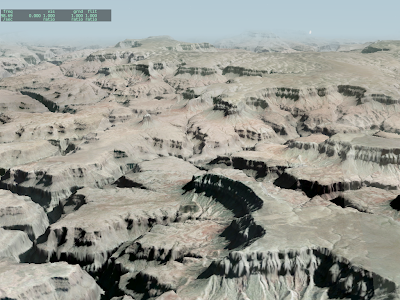
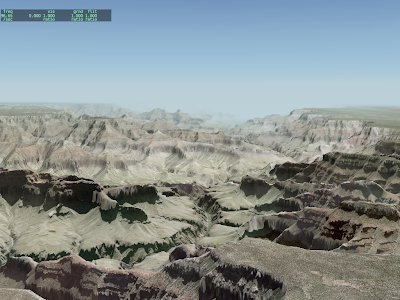
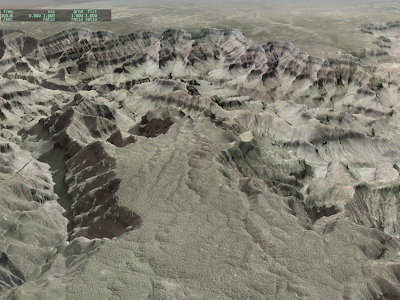
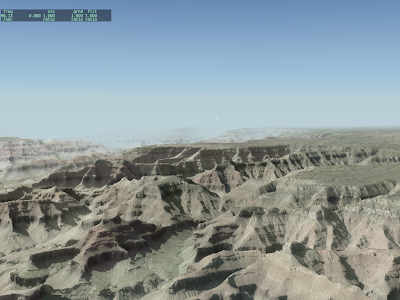
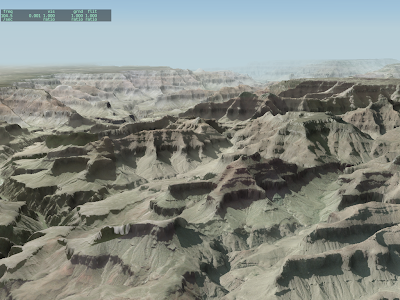
Clearly we need more than 25 nm visibility in some cases!




